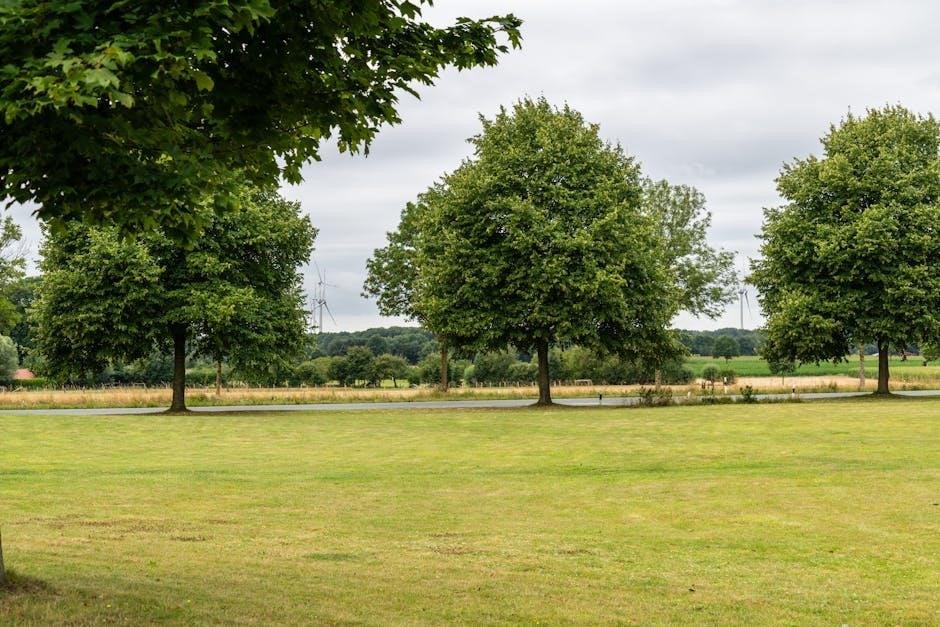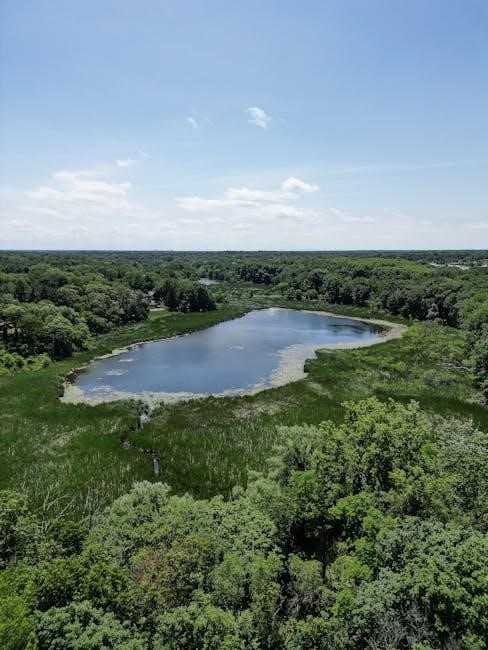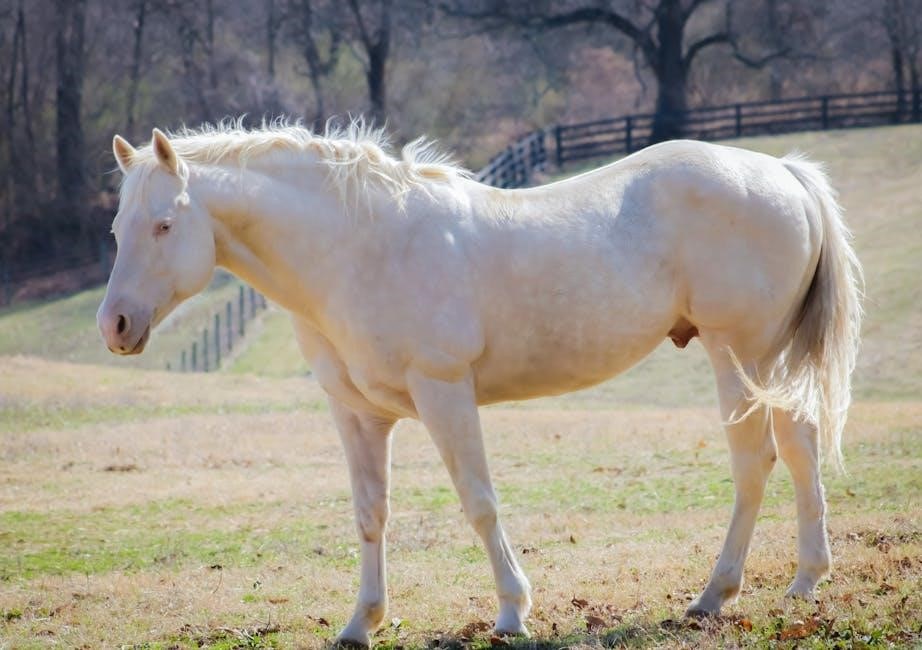Michigan boasts a rich diversity of tree species, with over 75 native types, ranging from deciduous giants like sugar maple to coniferous staples like balsam fir. Field guides, such as those from MSU CANR, offer detailed descriptions, photographs, and identification keys, making it easier for enthusiasts and professionals to explore and understand the state’s arboreal wonders.
Overview of Michigan’s Forest Ecosystem
Michigan’s forest ecosystem is a vibrant tapestry of deciduous and coniferous species, spanning over 20 million acres. These forests are dominated by trees like sugar maple, red oak, and eastern white pine, creating habitats for diverse wildlife. Wetlands, riparian zones, and upland forests support complex ecological processes, making Michigan a critical region for biodiversity. The state’s forests play a vital role in carbon sequestration, water filtration, and soil conservation. Conservation efforts, including sustainable forestry practices, are essential to protect these ecosystems. Michigan’s forest ecosystem is not only ecologically significant but also economically vital, supporting industries like timber and tourism while providing recreational opportunities for residents and visitors alike.
Importance of Tree Identification
Tree identification is crucial for understanding Michigan’s ecosystems and managing its forests sustainably. Accurate identification helps in distinguishing native species from invasive ones, which is vital for conservation efforts. It also aids in habitat restoration and supports wildlife by ensuring the right tree species are planted. For foresters, landowners, and enthusiasts, proper identification enables effective forest management, enhancing biodiversity and ecosystem health. Field guides, like those from MSU CANR, provide essential tools for learning tree characteristics, ensuring informed decisions in environmental stewardship and education. By fostering a deeper connection with nature, tree identification promotes appreciation and responsible care for Michigan’s arboreal heritage, benefiting both the environment and future generations.
Deciduous Trees of Michigan
Michigan’s deciduous trees, such as Largetooth Aspen, American Basswood, and Sugar Maple, dominate the state’s forests, offering vibrant seasonal changes and diverse ecological roles.
Largetooth Aspen (Populus grandidentata)
Largetooth Aspen is a deciduous tree native to Michigan, known for its striking white bark and broad leaves. It thrives in moist soils and cooler climates, often forming large colonies. This species is valued for its rapid growth and ability to regenerate quickly. In Michigan, it is commonly found in northern regions and along riversides. The Largetooth Aspen plays a crucial role in local ecosystems, providing habitat for various wildlife. Its leaves, with coarsely toothed edges, turn golden yellow in autumn, adding to the state’s scenic beauty. Field guides often highlight its distinctive characteristics for easy identification during hikes or nature walks.
American Basswood (Tilia americana)
American Basswood is a deciduous tree native to Michigan, thriving in moist, fertile soils. It is recognized for its large, heart-shaped leaves and fragrant, pale-yellow flowers. This tree grows up to 80 feet tall, with a broad, rounded crown. Basswood is often found in woodlands and along streams. Its wood is valued for carving and furniture-making. The tree’s flowers attract pollinators, while its leaves provide food for wildlife. In Michigan, American Basswood is common in the southern and central regions. Field guides note its distinctive leaf veins and smooth bark, making identification straightforward. It is a key species in maintaining Michigan’s forest diversity and ecosystem balance.
American Beech (Fagus grandifolia)
American Beech is a deciduous tree native to Michigan, known for its smooth, gray bark and dark green, simple leaves with wavy margins. It thrives in shaded, moist environments, often forming the understory in forests. Beech trees grow up to 60 feet tall, with a spreading canopy. Their small, edible nuts are a vital food source for wildlife. In Michigan, American Beech is common in woodlands and along streams. Field guides highlight its distinctive bark and foliage for easy identification. This species plays a crucial role in maintaining forest ecosystems, providing habitat and sustenance for various animals and insects. Its tolerance for shade makes it a key component of Michigan’s diverse tree population.
Paper Birch (Betula papyrifera)

Paper Birch (Betula papyrifera) is a deciduous tree native to Michigan, recognized by its striking white, papery bark that peels horizontally. It thrives in well-drained soils and full sun, often found in northern regions. Growing up to 70 feet tall, it has a slender trunk and a spreading canopy. Its leaves are simple, alternate, and double-toothed, turning yellow in fall. Paper Birch is a pioneer species, colonizing disturbed areas like burns or logged sites. Its bark is highly ornamental, while its wood is valued for pulp and furniture. Wildlife relies on its seeds and buds for food. This species is a common sight in Michigan’s forests, adaptable and resilient, making it a key part of the state’s ecological landscape.

Coniferous Trees of Michigan
Michigan’s coniferous trees are highly adaptable, thriving in various habitats across the state. Species like balsam fir and eastern white pine are common, providing year-round greenery and ecological balance.
Balsam Fir (Abies balsamea)
The Balsam Fir is a native Michigan tree, commonly found in the state’s northern regions. It is a medium-sized evergreen with soft, fragrant needles and a slender profile. The needles are dark green on top and silvery-white on the bottom, arranged in a flattened, two-ranked pattern. Balsam Fir cones are upright, cylindrical, and covered in resin, turning from purple to brown as they mature. This tree thrives in cool, moist environments and is often used for timber and Christmas trees. Its aromatic scent and distinctive needle arrangement make it a favorite for identification in Michigan’s forests.
Eastern White Pine (Pinus strobus)
The Eastern White Pine is one of Michigan’s most iconic and versatile native trees. Known for its long, soft needles in bundles of five, it is a large evergreen that can grow up to 80 feet tall. Its broad, irregular crown and reddish-brown bark, which peels into thin scales, make it easily recognizable. Eastern White Pine thrives in well-drained soils and is often found in mixed forests. It is highly valued for its timber and is a popular choice for landscaping due to its rapid growth and aesthetic appeal. The tree’s large, cylindrical cones produce edible seeds, making it a vital part of Michigan’s ecosystems and a favorite among naturalists and foresters alike.
Tree Identification Techniques
Examine leaves, bark, flowers, fruits, and cones to identify Michigan trees. Field guides with photos and keys provide essential tools for accurate and efficient species recognition.
Using Leaf Characteristics for Identification

Leaf characteristics are crucial for identifying Michigan’s tree species. Examine shape, size, arrangement, and venation patterns. Simple leaves, like those on oaks, differ from compound leaves, such as walnuts. Margins may be toothed, lobed, or smooth. Leaf arrangement—alternate, opposite, or whorled—provides additional clues. Field guides often include detailed illustrations and dichotomous keys to help distinguish species. For example, the sugar maple has palmate venation with five lobes, while the red oak displays deep lobes with bristle-tipped teeth. These features, combined with seasonal changes in color, aid in accurate identification. Utilizing high-quality photographs and descriptive details ensures effective use of leaf traits for tree recognition.
Bark Patterns and Tree Shapes
Bark patterns and tree shapes are essential for identifying Michigan’s tree species. Examine bark texture, color, and markings, such as ridges, furrows, or peeling layers. Paper birch has white, papery bark, while red oak displays deep furrows. Tree shapes vary widely, from the towering, columnar form of eastern white pine to the broad canopy of sugar maple. Field guides often highlight these features, with photographs showcasing seasonal changes. Bark patterns, like the horizontal lenticels on American beech, provide unique clues. Observing overall shape and bark details helps narrow down species identification, especially during winter when leaves are absent. These visual cues are invaluable for accurately recognizing Michigan’s diverse tree species.
Flowers, Fruits, and Cones
Flowers, fruits, and cones are critical for identifying Michigan’s tree species. Many trees produce distinctive flowers, such as the catkins of Largetooth aspen or the fragrant blooms of American basswood. Fruits like the samaras of sugar maple and the acorns of red oak are key identifiers. Conifers produce cones, with species like balsam fir and eastern white pine having unique cone shapes and sizes. Field guides often include detailed images of these features, helping users recognize patterns and seasonal variations. Observing these reproductive structures, along with their colors and textures, provides essential clues for accurate tree identification, especially when leaves are absent or less distinctive.

Michigan Tree Identification Guide
The Michigan Tree Identification Guide is a comprehensive resource, featuring detailed descriptions, photographs, and identification keys. It covers 105 species, including Largetooth aspen and sugar maple, with thumb tabs and height comparisons for easy navigation, making tree identification straightforward and efficient for enthusiasts and professionals alike. Digital versions are available for free from MSU CANR, offering a practical tool for exploring the state’s diverse arboreal landscape. This guide simplifies the process of identifying trees, ensuring accurate and productive experiences in Michigan’s forests. Its user-friendly design and wealth of information make it an indispensable companion for anyone interested in the state’s tree species. The guide is particularly useful for education and conservation efforts. Michigan’s tree species are diverse, ranging from deciduous to coniferous, each with unique characteristics. The guide helps users recognize these features, aiding in accurate identification. Whether for study or outdoor activities, this guide is a valuable resource. It is widely recommended for its clarity and thoroughness. The guide’s structure allows for quick access to information, enhancing the learning experience. By using this guide, users can deepen their understanding of Michigan’s ecosystems and conservation needs. It serves as a vital tool for environmental stewardship and education. The guide’s popularity stems from its effectiveness in making complex information accessible. It is a trusted resource for tree identification in Michigan.
Field Guide Structure and Features
The field guide is structured for easy navigation, featuring thumb tabs for quick access to species sections. It includes detailed descriptions, high-quality photographs, and height comparisons to aid accurate identification. The guide covers 105 Michigan tree species, with each entry highlighting key characteristics such as leaf shapes, bark patterns, and fruit types. Its user-friendly design ensures that both beginners and experts can efficiently identify trees. The inclusion of visual aids enhances the learning experience, while the compact format makes it portable for field use. This guide is a valuable tool for nature enthusiasts, educators, and conservationists, providing essential information for understanding and appreciating Michigan’s diverse tree species. Its clear structure and comprehensive content make it an indispensable resource for tree identification.
Visual Aids and Photographs
The field guide is enriched with high-quality photographs and detailed illustrations, showcasing key features of Michigan’s tree species. These visuals include images of leaves, bark, flowers, and fruits, enabling precise identification. Comparison charts and diagrams further assist in distinguishing similar species. The guide’s use of professional photography ensures clarity, with images capturing the unique characteristics of each tree. Illustrations of leaf venation patterns, cone shapes, and bark textures provide additional clarity. The visual aids are complemented by clear labels and descriptions, making complex identification processes more accessible. This emphasis on visual learning ensures that users can confidently identify trees, even in challenging conditions. The guide’s commitment to visual excellence enhances its practicality and educational value.
Thumb Tabs and Height Comparisons
The field guide incorporates thumb tabs for quick navigation, allowing users to flip effortlessly between sections. Height comparisons are prominently featured, providing a visual reference for tree sizes. This feature helps users gauge the mature height of each species, aiding in identification. The tabs are color-coded or labeled by tree type, enhancing organization. Height charts display ranges in both feet and meters, catering to diverse users. These tools streamline the identification process, making the guide user-friendly. The combination of thumb tabs and height comparisons ensures efficient and accurate tree identification, whether in the field or for educational purposes. This practical design underscores the guide’s utility for both professionals and enthusiasts.
Ecological Roles of Michigan Trees
Michigan’s trees are vital for wildlife habitats, soil health, and climate regulation, supporting diverse ecosystems while providing aesthetic and recreational value to communities across the state.
Habitats and Growth Conditions
Michigan’s tree species thrive in diverse habitats, from wetlands to dry uplands, reflecting the state’s varied landscape. Trees like Red Maple excel in wet environments, while Oaks prefer drier soils. The state’s forests and urban areas support a wide range of tree growth, with species adapting to local soil and moisture conditions. Field guides detail these specific growth preferences, aiding in identification and understanding of ecological roles. Native species are well-suited to Michigan’s climate, ensuring healthy growth across different regions. This diversity highlights the importance of conservation efforts to protect these habitats and promote sustainable tree populations;
Wildlife Support and Ecosystem Services
Michigan’s trees play a vital role in supporting wildlife and maintaining healthy ecosystems. They provide food, shelter, and nesting habitats for countless species, from pollinators to large mammals. Trees like Sugar Maple and Red Oak produce fruits and nuts that sustain wildlife throughout the year. Additionally, tree root systems stabilize soil, prevent erosion, and contribute to water filtration, ensuring clean water sources. Forests also act as carbon sinks, mitigating climate change by absorbing greenhouse gases. These ecosystem services highlight the importance of preserving Michigan’s tree populations for both biodiversity and environmental balance. Protecting these trees is essential for maintaining the delicate interplay between flora and fauna in the state’s ecosystems.

Common Michigan Tree Species
Michigan’s forests feature iconic species like Sugar Maple, Red Oak, and Eastern Redbud. These trees, along with others, are detailed in field guides for easy identification.
Sugar Maple (Acer saccharum)
The Sugar Maple, a cornerstone of Michigan’s forests, is renowned for its striking fall colors and role in maple syrup production. Its leaves, with five distinct lobes, turn brilliant shades of orange, red, and yellow. The bark, smooth and gray when young, becomes rugged with age. This species thrives in eastern Michigan’s deciduous forests, often growing tall and straight. Field guides highlight its importance for both ecological balance and economic value. Identification is made easier by its unique leaf veins and vibrant seasonal changes, making it a favorite for naturalists and enthusiasts alike.

Red Oak (Quercus rubra)
The Red Oak is a widely distributed and ecologically vital tree in Michigan, known for its striking red foliage in autumn. Its leaves feature 7 to 11 lobes with sharp tips, turning deep red to burgundy in fall. Mature trees can reach up to 75 feet tall, with a broad, rounded crown and sturdy branches. The bark is gray, developing deep furrows as the tree ages. Red Oak is valued for its timber and as a habitat for wildlife. It thrives in various soils and is often found in deciduous and mixed forests. Field guides emphasize its longevity, with some specimens living up to 300 years, making it a cornerstone of Michigan’s ecosystems.
Eastern Redbud (Cercis canadensis)
The Eastern Redbud is a stunning deciduous tree native to Michigan, recognized for its vibrant pink flowers that bloom in early spring. Its heart-shaped leaves are dark green in summer, turning golden-yellow in fall. Mature trees grow up to 35 feet tall, with a broad, spreading canopy. The bark is smooth and gray, becoming scaly with age. Eastern Redbud thrives in well-drained soils and partial shade, making it a popular ornamental choice. It supports pollinators and wildlife, adding beauty and ecological value to Michigan’s landscapes. Field guides highlight its relatively small size and striking floral displays, making it a favorite for gardeners and nature enthusiasts alike.
Tree Planting and Conservation
Planting native Michigan trees supports local ecosystems and reduces invasive species threats. MSU CANR provides resources for selecting and planting appropriate species, ensuring conservation success and biodiversity.
Native vs; Invasive Species
Distinguishing between native and invasive tree species is crucial for Michigan’s ecosystem. Native species, like sugar maple and red oak, support local wildlife and maintain ecological balance. In contrast, invasive species such as the emerald ash borer disrupt native habitats and harm biodiversity. Field guides highlight these differences, aiding in identification and control. Resources from MSU CANR emphasize the importance of planting native trees to prevent invasive takeovers, ensuring sustainable forest health and protecting Michigan’s natural heritage for future generations.
Conservation Efforts in Michigan
Michigan’s conservation initiatives focus on preserving its vast forests and diverse tree species. Programs like reforestation and habitat restoration are vital to maintaining ecological balance. MSU CANR and other organizations provide resources, including free guides, to educate the public on tree identification and sustainable practices. Controlling invasive species and protecting native trees are central to these efforts. By promoting eco-friendly land management and community involvement, Michigan aims to safeguard its forests for future generations, ensuring healthy ecosystems and biodiversity.

Resources for Further Learning
Michigan’s tree identification is supported by resources like MSU CANR’s free guides and Stan Tekiela’s field guide, offering detailed information and visual aids for enthusiasts and experts alike.
Michigan State University Extension Resources
Michigan State University Extension provides invaluable resources for tree identification and forestry education. Their publications, including the Identifying Trees of Michigan guide, offer detailed descriptions, illustrations, and keys to help users accurately identify species. Digital versions of these guides are available for free, making them accessible to a wide audience. MSU Extension also hosts webinars, workshops, and fact sheets on tree care, planting, and conservation. These resources are tailored for homeowners, landowners, and natural resource professionals, ensuring comprehensive coverage of Michigan’s tree species. By leveraging MSU Extension’s expertise, individuals can gain a deeper understanding of the state’s forests and contribute to their conservation and sustainable management.

Recommended Field Guides

Several field guides are highly recommended for identifying Michigan’s tree species. Stan Tekiela’s Trees of Michigan Field Guide is a standout resource, featuring stunning photographs, thumb tabs for easy navigation, and detailed descriptions of 105 species. Another excellent option is the Identifying Trees of Michigan guide from Michigan State University Extension, which is available for free download. These guides provide essential information on leaf characteristics, bark patterns, and growth habits, making tree identification accessible to both beginners and experts. They also highlight the ecological roles of trees and offer insights into conservation efforts. Whether you’re a student, landowner, or nature enthusiast, these field guides are indispensable tools for exploring Michigan’s diverse tree species.
